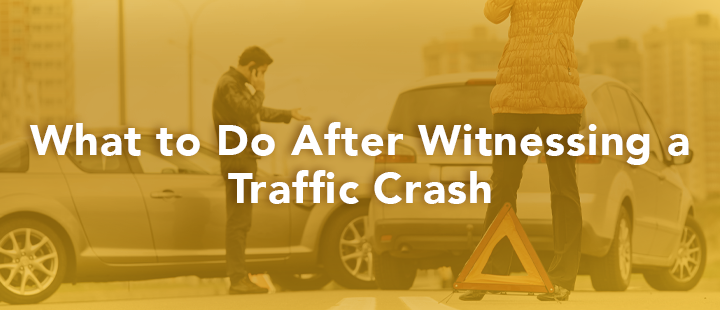You’re driving along the highway peacefully when suddenly you see a car in front of you swerve, lose control, and smash into the roadside barrier. Broken glass litters the road as you pass by the vehicle. Do you stop or keep going? Do you call for help? Witnessing a traffic crash can make your head spin with questions, emotions, and adrenaline. The most important thing you can do is think rationally and act quickly — you could wind up saving a life.
Here’s what you should do after witnessing a traffic crash.
Read, ‘2020 Illinois Crash Statistics.’
Step 1: Keep Yourself Safe
First and foremost, keep yourself safe. Once you’ve passed the crash site, pull over to the side of the road at a safe distance and make sure it’s clear before you get out. Do not ever stop or exit your vehicle in the middle of the road. When pulling over, make sure you keep some distance between yourself and the crash, for a few reasons:
- Make room for emergency vehicles to work
- Stay out of harm’s way if a vehicle fire occurs
- If the crashed car is in the middle of the road, it could cause a pileup — especially if visibility is low due to weather or time of day
If the incident occurs on a busy road, it is safer to remain in your vehicle.
Note: if you are involved in the crash in any capacity, the law requires you to stop. Failing to do so will result in a hit-and-run charge.
Step 2: Call For Help
Once you are safely pulled to the side of the road and out of immediate danger, use your phone to call 911 and report the accident. If possible, try to remember which intersection or highway exit is nearest, which direction you are traveling, and the number of vehicles involved in the crash. Time is of the essence!
If, for whatever reason, you do not have a cell phone available, drive to the nearest business and tell an employee to call the police.
Step 3: Help if You Can
While on the phone with 911, walk over to the crashed vehicle if there is no immediate threat (eg. fire, fast moving traffic). Check on the vehicle’s occupants to see if they have injuries and report them to the 911 dispatcher. If you are a medical professional, you may be able to administer first aid without risk of legal liabilities, depending on the state. Do NOT attempt to provide first aid if you are not a trained nurse, EMT, or physician. In some extreme cases, such as if the person is in imminent danger of dying, you may be able to help in other ways. For instance, if they are heavily bleeding you could help apply pressure to a wound. Do not move the person unless they are in imminent danger; you could worsen their injuries.
Step 4: Remain On the Scene
As a firsthand witness to the traffic crash, you will probably be asked to give a statement to police. If multiple vehicles are involved in the crash, your testimony will help paint a clearer picture and shed some light on who was at fault. You do not want to confront the driver(s) at the crash site, even if they are at fault — adrenaline is flowing, emotions are running wild, and you don’t know how someone will react to being accused in the moment. If two drivers are arguing with each other, it’s safest to stay away and out of the confrontation. Take pictures of the crashed vehicles’ license plates to keep an unbiased record of what happened. It could especially come in handy if one of the drivers flees the scene.
Witnessing a traffic crash can be a traumatizing event, especially if a fatality is involved. If you notice signs of depression, anxiety, or other negative effects on your mental health following a crash, get in touch with a therapist to help you cope. But knowing what to do when you witness a crash will help you think clearly, act quickly and potentially save lives.
Learn more about our Illinois Online Driving Program or contact Top Driver with any questions.

